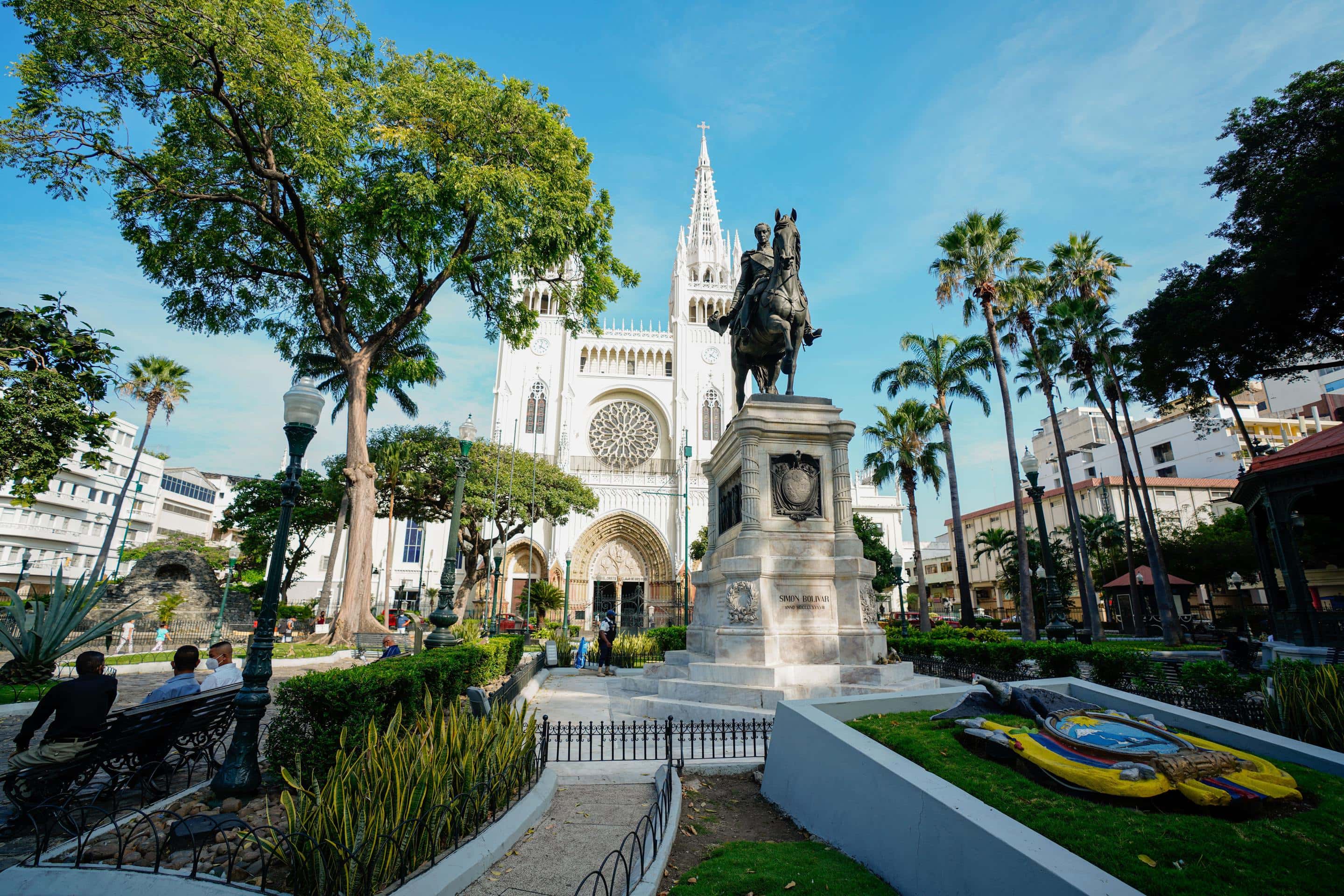Explore Ecuador
Discover colonial centers dotted by majestic churches, dramatic Andean peaks and mystic cloud forests, as well as unique biodiverse islands that make Ecuador one of South America’s most coveted destinations.
Quito
Ecuador’s capital Quito is situated at an altitude of 2,850 m (9,350 ft) above sea level, making it the second-highest capital in the world, after La Paz in Bolivia. Founded in the 16th century by the Spanish conquerors, the city of Quito has one of the most beautiful and best-preserved historic centers in South America, designated as one of the first World Heritage Sites by UNESCO in 1978. Endowed with a colonial charm and a rich cultural heritage, strolling around its cobblestone streets is a delightful treat. Discover the representations of the ‘Baroque school of Quito’, which combines indigenous and European art forms and traditions, such as the church of San Francisco, la Compañía de Jesús, and Santo Domingo. Another significant building in the city center is the neo-gothic style Basilica of the National Vow, which features iguanas and turtles instead of gargoyles on its exteriors.
An interesting fact about Quito is its unusual location on the eastern flanks of an active volcano. The Pichincha volcano can be accessed via the teleferiQo, a cable car that travels 2,237 linear meters up to Cruz Loma mountain for magnificent views of the city. From this point, it is possible to hike to the peak of the volcano Ruku Pichincha, across some of the most beautiful Andean landscapes.
Cloud Forests
A few hours’ drive northwest from the city of Quito will take you to one of Ecuador’s best hidden natural treasures: the mysterious cloud forests. The location on the slopes of the Andes mountains at an altitude ranging between 2,950 and 8,200 feet (900 to 2500 meters) creates a dense and humid habitat populated with an immense variety of flora and fauna. The Chocó-Andean Forest is one earth’s most biodiverse hotspots, as well as a bird-watching paradise with over 500 species, including a plethora of hummingbirds, golden-headed quetzals, and the legendary Andean cock-of-the-rock (Rupicola Peruvianus). It is also home to one of the richest collections of orchids, ferns, bromeliads, and other magnificent plant species.
Adventure lovers will be able to find amazing thrills that cater to all levels of skill from zip-lining, rappelling down waterfalls and rafting, to mountain biking and hiking across rich beautiful landscapes. The best way to get the most out of your visit to the cloud forests is by staying at one of the eco-friendly lodges available in the area, as they will have a range of activities on offer, some within their own private reserve.
Avenue of the Volcanoes
The Avenue of the Volcanoes is a long corridor of snow-tipped volcanoes situated between two parallel ‘cordilleras’ or mountain ranges in Ecuador’s Sierra Central. It was named as such by German geographer and naturalist Alexander von Humboldt in the early 19th century when he noticed it contained eight of the ten highest peaks in Ecuador. As part of the epic Ring of Fire, many volcanoes in this mountain range are active, as is the case of Cotopaxi, the most impressive of them all. At 19,350 feet (5,897 meters), it is one of the world’s highest active volcanoes and surely one of the most beautiful with a nearly symmetrical cone shape and white peak, making it picture-perfect. Surrounding it is Cotopaxi National Park, a protected area of stunning natural landscapes, with opportunities for hiking and horseback riding activities.
A visit to the Avenue of the Volcanoes is also a great way to connect with the people and culture of the Andes as you explore nearby local villages, colorful artisan markets or choose to stay in one of the traditional family haciendas established in the area.
Guayaquil

Guayaquil is Ecuador’s largest city and capital of the coastal Guayas Province. As the major gateway to the Galapagos Islands, you can allocate some time to relax and explore this bustling port city and economic hub. Include a stroll along Malecon 2000, a boardwalk stretching over 1.5 miles (2.5 kilometers) along the Guayas River that has become a symbol of Guayaquil’s urban transformation, scattered with restaurants, green spaces, museums, sculptures, and monuments.
Also worth visiting is the Historic Park, built in 1997 by the Central Bank of Ecuador as a touristic and educational site showcasing the history, culture, and nature of Guayaquil. Among its main attractions are recreations of the architecture of Guayaquil’s prosperous era during the beginning of the 20th century, a space focused on urban and rural traditions, and a four-hectare area dedicated to endangered wildlife.
Cuenca

The historic city of Cuenca in southern Ecuador exudes Spanish colonial charm. Founded in 1577 following the guidelines provided 30 years earlier by the Spanish King Charles V, it is one of the best examples of Spanish urban planning in the Americas, thanks to over 400 years of preservation. Its historic center, Santa Ana de los Ríos de Cuenca, is declared a UNESCO World Heritage Site and features beautiful architecture including Cuenca’s New Cathedral which stands out for its three giant domes of blue and white glazed tiles brought from Czechoslovakia. Opposite stands the Old Cathedral, built in the same year of the town foundation in 1557 and now transformed into the Museum for Religious Art.
In the same province of Azuay, located just 18 miles (30 kilometers) west of Cuenca, is another of Ecuador’s most stunning protected natural areas, El Cajas National Park. Pristine rugged landscapes featuring hundreds of crystalline lakes and lagoons spread out across an area of 28,000 hectares (69,200 acres), make this an ideal day trip for hiking and nature adventures. Also rich in flora and fauna, bird sightings include the South American condor, the giant hummingbird, and the Curiquinga (Phalcoboenus carunculatus), also known as the royal bird of the Incas, while animal encounters may include foxes, porcupines, llamas, mountain foxes, and if you’re extra fortunate, pumas.




